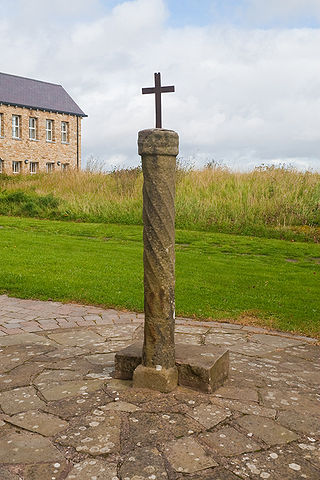Saints are usually pictured as haloed and in Heaven, but legends say that Saint Patrick did a Dante and paid a visit to Purgatory and perhaps even Hell.

In approximately 445 AD, in between founding churches and working as a missionary in southern Donegal in Ireland, St Patrick is reputed to have visited a cave in the middle of a lake, where he spent time alone in penance and prayer.
Now, the legends about Patrick and this cave vary. Some say that he was frustrated by the difficulty of converting the people of Ireland, because they demanded proof of his teachings. When Patrick prayed for assistance, he was led (legends don't say how) to a hole in the ground that was the entrance to Purgatory and, subsequently, Heaven and Hell. Other legends state that while he was inside this cave, he received visions of Hell.
A particularly fanciful legend includes a monster who lived in the lake – a water serpent called the Corra. According to this account, Patrick found the serpent lying in the shallows and she swallowed him whole. Two days later, he managed to cut his way out of the monster, killing her in the process. At the time, the lake ran red with her blood, giving rise to the lake's name in the present day: Loch Dearg, the red lake. The serpent's body turned to stone and formed the islands where he found the cave. She was reputed to be the last snake in Ireland, so Patrick's battle with her was a symbolic battle with the devil – and his final battle with snakes.

Purgatorium S. Patritij, huius Diui precibus hoc loco à Deo constitutum. Syl. Gyraldus.
Translated: The Purgatory of Saint Patrick, whose prayers in this place prompted its establishment by God, according to Sylvius Gyraldus.
Whatever the truth of any of these legends, St Patrick did visit the region and the islands in Loch Dearg became a sought-after sanctuary for pilgrims who wished to be purged of their sins.
Saint Patrick's Purgatory

Then, as now, pilgrims would approach the lake and take boats to the islands in the centre of Loch Dearg. St Patrick's cave is believed to be on Station Island, while nearby Saints Island, once a key part of the original lengthy pilgrimage, is now home only to ruins.
Station Island

The oldest structure on Station Island is a structure known as St Patrick's Cross, one of the stations where pilgrims traditionally say prayers.


The spirals traced up the column and the lines carved into its capital are consistent with stonemasonry from the 9th century AD, making it over a thousand years old. Near it are the so-called penitential beds, each dedicated to a saint: St Patrick, St Brigid, St Davog, St Catherine of Alexandria, St Brendan, St Molaise and St Columba. The low stone walls of these beds are the remains of round stone huts or monks' cells from an earlier monastery at the site.
The cave on Station Island was in use until 1780, when it was filled in and a chapel was constructed. This has since been replaced with the octagonal St Patrick's Basilica, which towers over all the other structures on the island.

The Pilgrimage
Both Saints and Station Islands were host to a monastic community from the time of St Patrick. The first monastery was constructed on Saints Island, formerly known as St Davog's Island, as St Davog (also called St Dabheog or Dabheoc) was the first abbot of the monastery, the local patron of Loch Dearg and a disciple of St Patrick during St Patrick's lifetime.
The earliest written record of a pilgrimage to St Patrick's Purgatory is Henry of Saltry's account of Knight Owein's Pilgrimage and Purgatory in 1153, though it wasn't written until 1186.
A more detailed account from 1353 indicates that a pilgrim crossed the lake to the monastery at what is now Saints Island, where they went to confession, did penance, prayed and fasted for fifteen days before a requiem mass (usually only held for funerals) was held for them, permitting them entry into Purgatory. Only then were they ferried by boat across to Station Island and enclosed in the cave for a twenty-four hour vigil.
The cave was described as three feet wide, nine feet long and high enough for a man to kneel but not stand upright.
When the twenty-four hour vigil was complete, the door would be opened and if the pilgrim was still alive, they were permitted to return to Saints Island to undergo another fifteen days of fasting and prayer.
In 1517, fifteen days was reduced to nine until 1804, when the entire pilgrimage was reduced to the present total of three days. In the present day, it's considered to be one of the most gruelling Christian pilgrimages in the world, yet it's a pilgrimage that's been undertaken by thousands of people every year.
Now, why the interest in an ancient monastery and pilgrimage site on the other side of the world? Why, it was research for my Mel Goes to Hell series, where the present-day Saint Patrick plays a significant part (between his annual pilgrimages, of course), along with other angels and Lucifer himself.
